Handwritten Digit String Recognition Using Deep Autoencoder Based Segmentation and ResNet Based Recognition Approach
Anuran Chakraborty,
Rajonya De,
Samir Malakar,
Friedhelm Schwenker,
Ram Sarkar

Auto-TLDR; Handwritten Digit Strings Recognition Using Residual Network and Deep Autoencoder Based Segmentation
Similar papers
A Fast and Accurate Object Detector for Handwritten Digit String Recognition
Jun Guo, Wenjing Wei, Yifeng Ma, Cong Peng

Auto-TLDR; ChipNet: An anchor-free object detector for handwritten digit string recognition
Abstract Slides Poster Similar
Recursive Recognition of Offline Handwritten Mathematical Expressions
Marco Cotogni, Claudio Cusano, Antonino Nocera

Auto-TLDR; Online Handwritten Mathematical Expression Recognition with Recurrent Neural Network
Abstract Slides Poster Similar
Recognizing Multiple Text Sequences from an Image by Pure End-To-End Learning
Zhenlong Xu, Shuigeng Zhou, Fan Bai, Cheng Zhanzhan, Yi Niu, Shiliang Pu
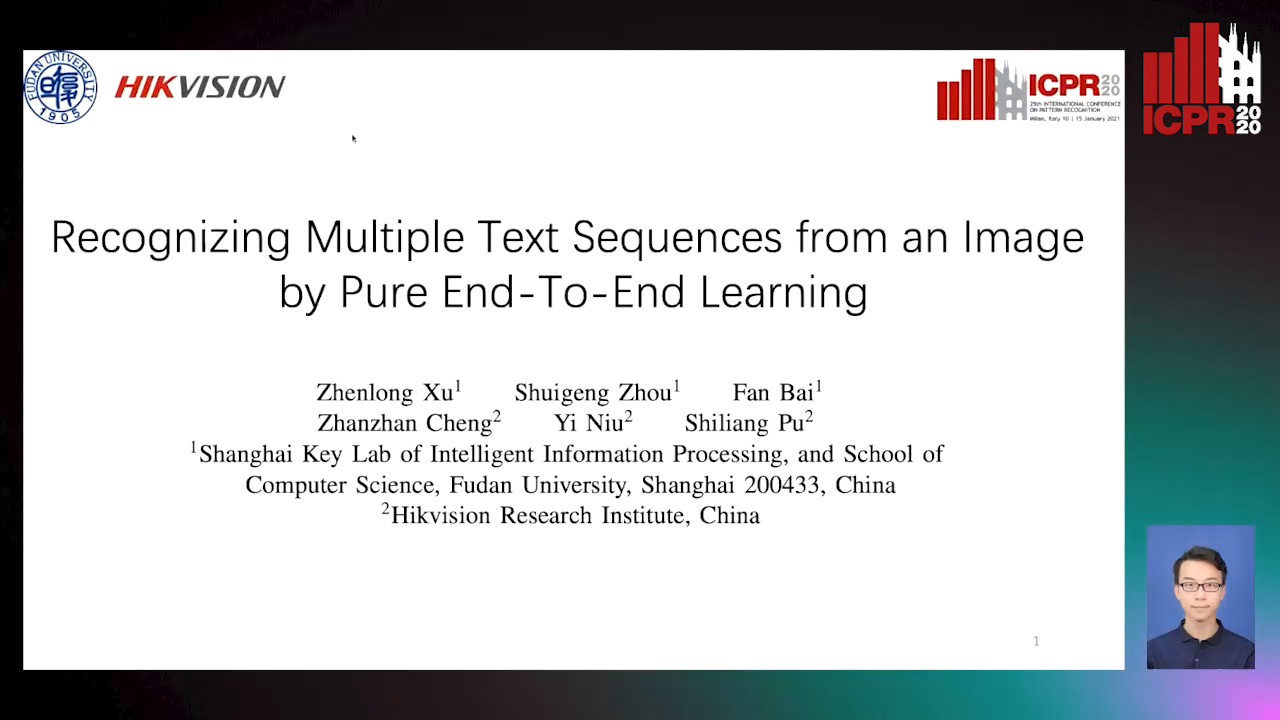
Auto-TLDR; Pure End-to-End Learning for Multiple Text Sequences Recognition from Images
Abstract Slides Poster Similar
Text Baseline Recognition Using a Recurrent Convolutional Neural Network
Matthias Wödlinger, Robert Sablatnig
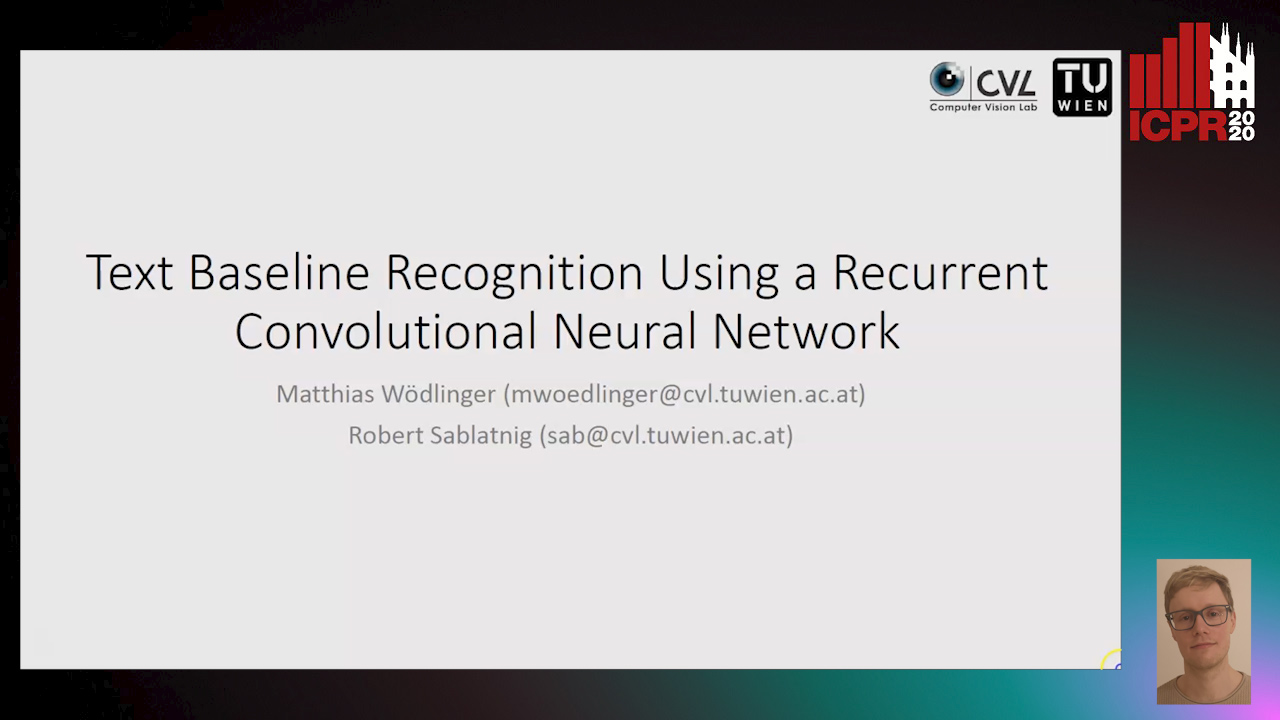
Auto-TLDR; Automatic Baseline Detection of Handwritten Text Using Recurrent Convolutional Neural Network
Abstract Slides Poster Similar
2D License Plate Recognition based on Automatic Perspective Rectification
Hui Xu, Zhao-Hong Guo, Da-Han Wang, Xiang-Dong Zhou, Yu Shi

Auto-TLDR; Perspective Rectification Network for License Plate Recognition
Abstract Slides Poster Similar
A Gated and Bifurcated Stacked U-Net Module for Document Image Dewarping
Hmrishav Bandyopadhyay, Tanmoy Dasgupta, Nibaran Das, Mita Nasipuri
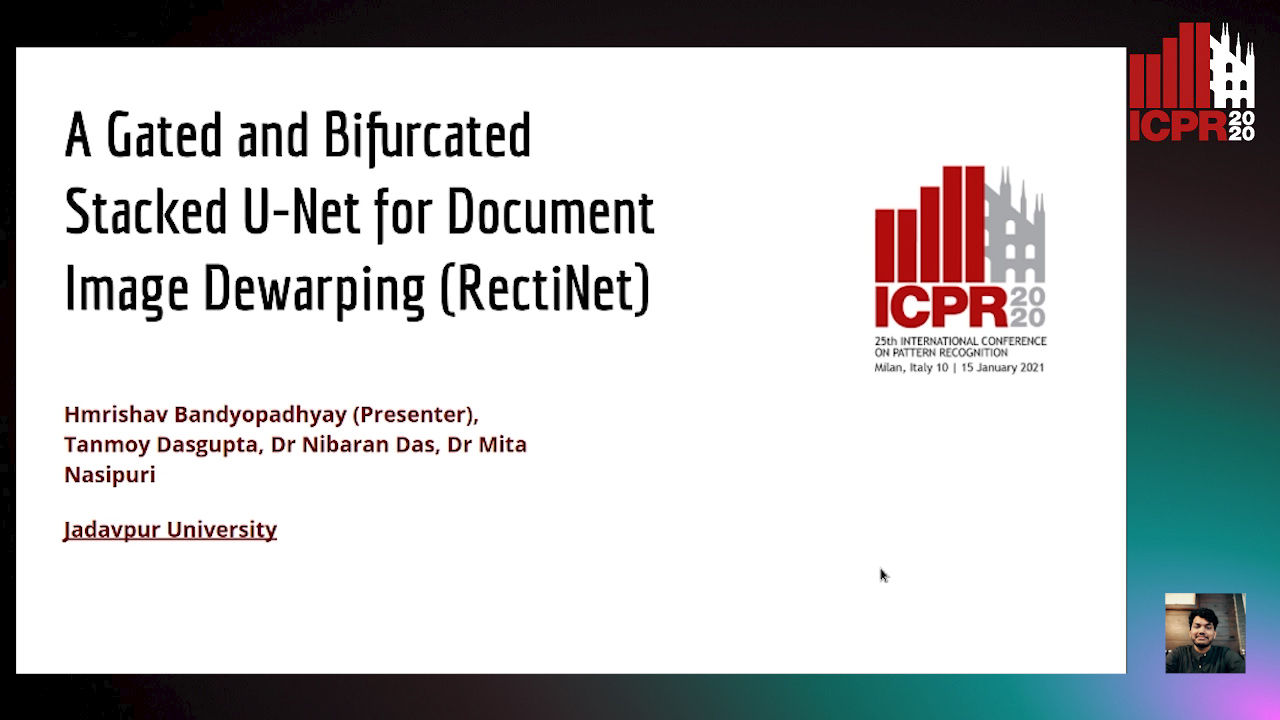
Auto-TLDR; Gated and Bifurcated Stacked U-Net for Dewarping Document Images
Abstract Slides Poster Similar
Improving Word Recognition Using Multiple Hypotheses and Deep Embeddings
Siddhant Bansal, Praveen Krishnan, C. V. Jawahar

Auto-TLDR; EmbedNet: fuse recognition-based and recognition-free approaches for word recognition using learning-based methods
Abstract Slides Poster Similar
Watch Your Strokes: Improving Handwritten Text Recognition with Deformable Convolutions
Iulian Cojocaru, Silvia Cascianelli, Lorenzo Baraldi, Massimiliano Corsini, Rita Cucchiara

Auto-TLDR; Deformable Convolutional Neural Networks for Handwritten Text Recognition
Abstract Slides Poster Similar
Online Trajectory Recovery from Offline Handwritten Japanese Kanji Characters of Multiple Strokes
Hung Tuan Nguyen, Tsubasa Nakamura, Cuong Tuan Nguyen, Masaki Nakagawa
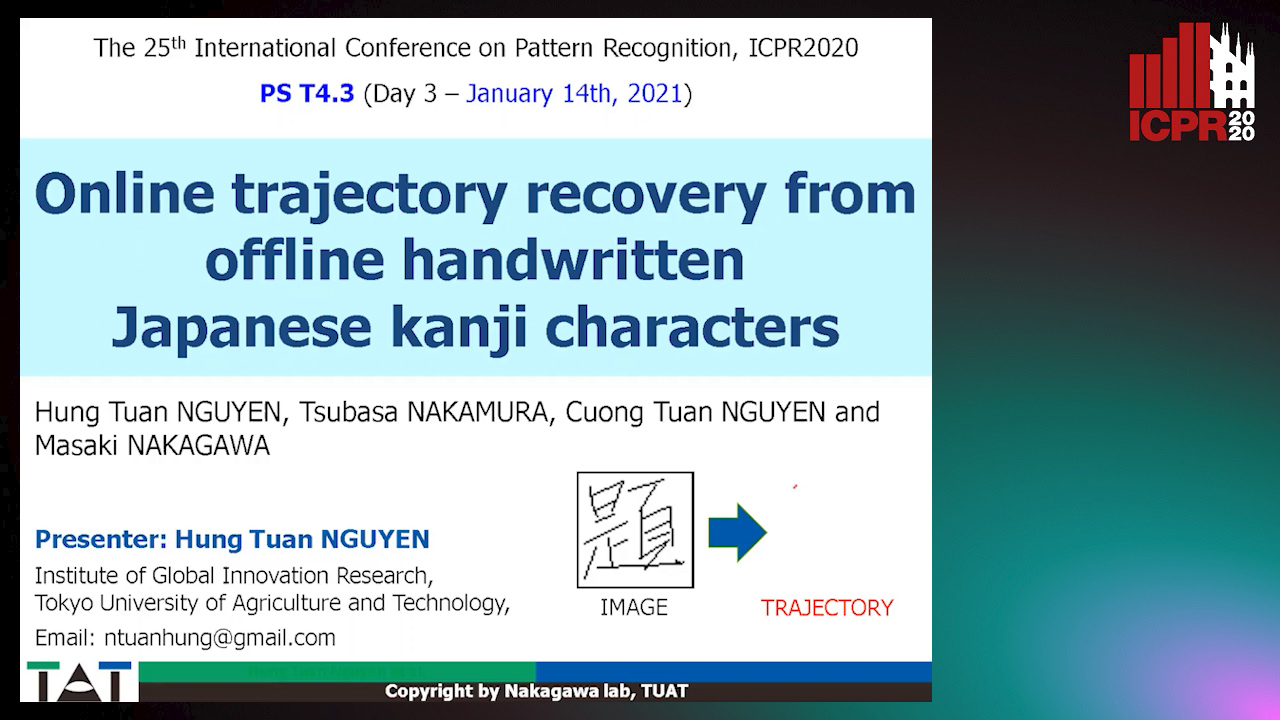
Auto-TLDR; Recovering Dynamic Online Trajectories from Offline Japanese Kanji Character Images for Handwritten Character Recognition
Abstract Slides Poster Similar
ReADS: A Rectified Attentional Double Supervised Network for Scene Text Recognition
Qi Song, Qianyi Jiang, Xiaolin Wei, Nan Li, Rui Zhang

Auto-TLDR; ReADS: Rectified Attentional Double Supervised Network for General Scene Text Recognition
Abstract Slides Poster Similar
Multiple Document Datasets Pre-Training Improves Text Line Detection with Deep Neural Networks
Mélodie Boillet, Christopher Kermorvant, Thierry Paquet

Auto-TLDR; A fully convolutional network for document layout analysis
LODENet: A Holistic Approach to Offline Handwritten Chinese and Japanese Text Line Recognition
Huu Tin Hoang, Chun-Jen Peng, Hung Tran, Hung Le, Huy Hoang Nguyen
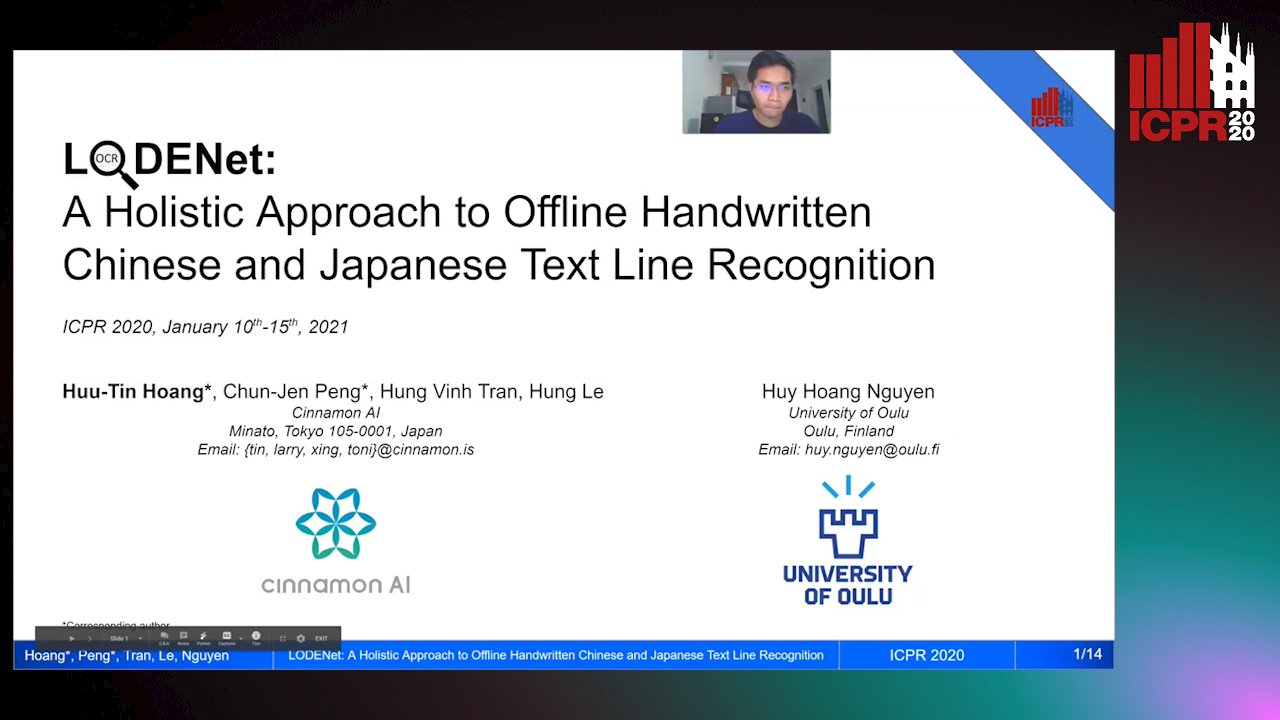
Auto-TLDR; Logographic DEComposition Encoding for Chinese and Japanese Text Line Recognition
Abstract Slides Poster Similar
GazeMAE: General Representations of Eye Movements Using a Micro-Macro Autoencoder
Louise Gillian C. Bautista, Prospero Naval

Auto-TLDR; Fast and Slow Eye Movement Representations for Sentiment-agnostic Eye Tracking
Abstract Slides Poster Similar
Combining Deep and Ad-Hoc Solutions to Localize Text Lines in Ancient Arabic Document Images
Olfa Mechi, Maroua Mehri, Rolf Ingold, Najoua Essoukri Ben Amara

Auto-TLDR; Text Line Localization in Ancient Handwritten Arabic Document Images using U-Net and Topological Structural Analysis
Abstract Slides Poster Similar
Writer Identification Using Deep Neural Networks: Impact of Patch Size and Number of Patches
Akshay Punjabi, José Ramón Prieto Fontcuberta, Enrique Vidal

Auto-TLDR; Writer Recognition Using Deep Neural Networks for Handwritten Text Images
Abstract Slides Poster Similar
Explorable Tone Mapping Operators
Su Chien-Chuan, Yu-Lun Liu, Hung Jin Lin, Ren Wang, Chia-Ping Chen, Yu-Lin Chang, Soo-Chang Pei
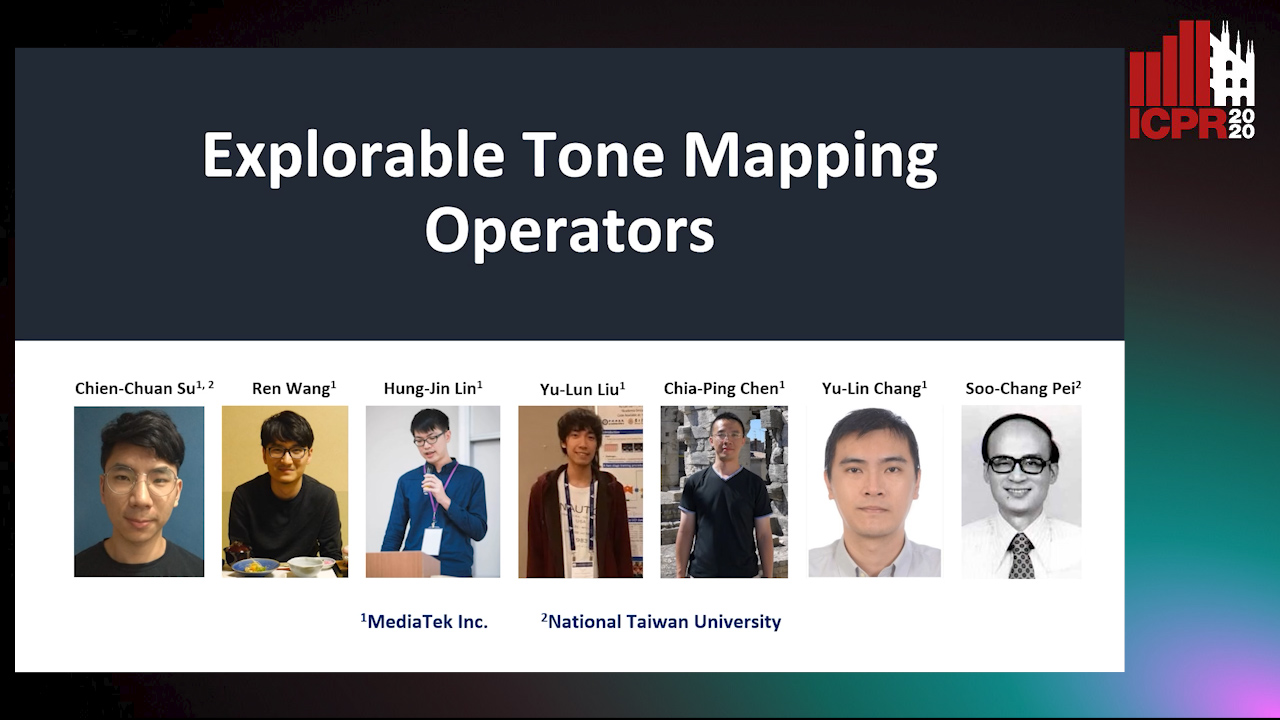
Auto-TLDR; Learning-based multimodal tone-mapping from HDR images
Abstract Slides Poster Similar
Stratified Multi-Task Learning for Robust Spotting of Scene Texts
Kinjal Dasgupta, Sudip Das, Ujjwal Bhattacharya

Auto-TLDR; Feature Representation Block for Multi-task Learning of Scene Text
Fast Approximate Modelling of the Next Combination Result for Stopping the Text Recognition in a Video
Konstantin Bulatov, Nadezhda Fedotova, Vladimir V. Arlazarov
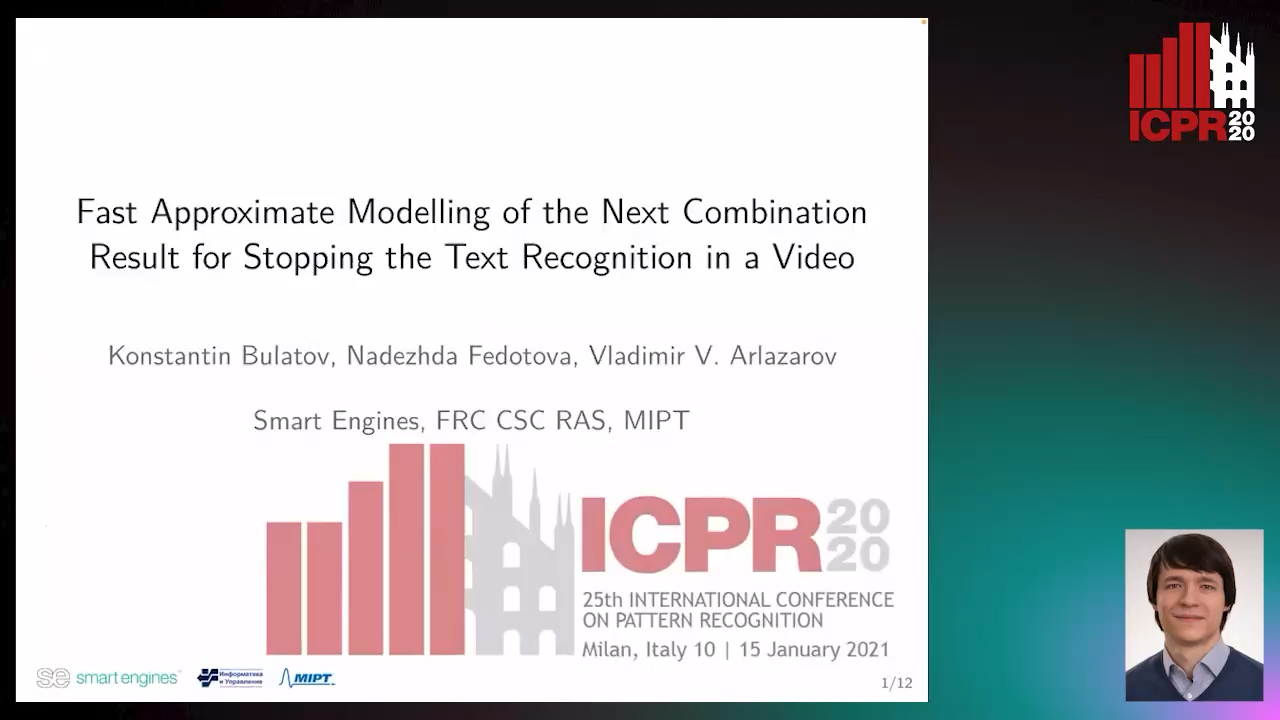
Auto-TLDR; Stopping Video Stream Recognition of a Text Field Using Optimized Computation Scheme
Abstract Slides Poster Similar
A Multi-Head Self-Relation Network for Scene Text Recognition
Zhou Junwei, Hongchao Gao, Jiao Dai, Dongqin Liu, Jizhong Han

Auto-TLDR; Multi-head Self-relation Network for Scene Text Recognition
Abstract Slides Poster Similar
Walk the Lines: Object Contour Tracing CNN for Contour Completion of Ships

Auto-TLDR; Walk the Lines: A Convolutional Neural Network trained to follow object contours
Abstract Slides Poster Similar
A Few-Shot Learning Approach for Historical Ciphered Manuscript Recognition
Mohamed Ali Souibgui, Alicia Fornés, Yousri Kessentini, Crina Tudor

Auto-TLDR; Handwritten Ciphers Recognition Using Few-Shot Object Detection
ConvMath : A Convolutional Sequence Network for Mathematical Expression Recognition
Zuoyu Yan, Xiaode Zhang, Liangcai Gao, Ke Yuan, Zhi Tang

Auto-TLDR; Convolutional Sequence Modeling for Mathematical Expressions Recognition
Abstract Slides Poster Similar
Ancient Document Layout Analysis: Autoencoders Meet Sparse Coding
Homa Davoudi, Marco Fiorucci, Arianna Traviglia

Auto-TLDR; Unsupervised Unsupervised Representation Learning for Document Layout Analysis
Abstract Slides Poster Similar
Enhancing Handwritten Text Recognition with N-Gram Sequencedecomposition and Multitask Learning
Vasiliki Tassopoulou, George Retsinas, Petros Maragos

Auto-TLDR; Multi-task Learning for Handwritten Text Recognition
Abstract Slides Poster Similar
Text Recognition in Real Scenarios with a Few Labeled Samples
Jinghuang Lin, Cheng Zhanzhan, Fan Bai, Yi Niu, Shiliang Pu, Shuigeng Zhou

Auto-TLDR; Few-shot Adversarial Sequence Domain Adaptation for Scene Text Recognition
Abstract Slides Poster Similar
Multi-Task Learning Based Traditional Mongolian Words Recognition
Hongxi Wei, Hui Zhang, Jing Zhang, Kexin Liu

Auto-TLDR; Multi-task Learning for Mongolian Words Recognition
Abstract Slides Poster Similar
Robust Lexicon-Free Confidence Prediction for Text Recognition
Qi Song, Qianyi Jiang, Rui Zhang, Xiaolin Wei

Auto-TLDR; Confidence Measurement for Optical Character Recognition using Single-Input Multi-Output Network
Abstract Slides Poster Similar
Text Recognition - Real World Data and Where to Find Them
Klára Janoušková, Lluis Gomez, Dimosthenis Karatzas, Jiri Matas

Auto-TLDR; Exploiting Weakly Annotated Images for Text Extraction
Abstract Slides Poster Similar
IBN-STR: A Robust Text Recognizer for Irregular Text in Natural Scenes
Xiaoqian Li, Jie Liu, Shuwu Zhang

Auto-TLDR; IBN-STR: A Robust Text Recognition System Based on Data and Feature Representation
Vision-Based Layout Detection from Scientific Literature Using Recurrent Convolutional Neural Networks

Auto-TLDR; Transfer Learning for Scientific Literature Layout Detection Using Convolutional Neural Networks
Abstract Slides Poster Similar
A Multi-Task Contextual Atrous Residual Network for Brain Tumor Detection & Segmentation
Ngan Le, Kashu Yamazaki, Quach Kha Gia, Thanh-Dat Truong, Marios Savvides

Auto-TLDR; Contextual Brain Tumor Segmentation Using 3D atrous Residual Networks and Cascaded Structures
A Benchmark Dataset for Segmenting Liver, Vasculature and Lesions from Large-Scale Computed Tomography Data
Bo Wang, Zhengqing Xu, Wei Xu, Qingsen Yan, Liang Zhang, Zheng You

Auto-TLDR; The Biggest Treatment-Oriented Liver Cancer Dataset for Segmentation
Abstract Slides Poster Similar
Recognizing Bengali Word Images - A Zero-Shot Learning Perspective
Sukalpa Chanda, Daniël Arjen Willem Haitink, Prashant Kumar Prasad, Jochem Baas, Umapada Pal, Lambert Schomaker

Auto-TLDR; Zero-Shot Learning for Word Recognition in Bengali Script
Abstract Slides Poster Similar
The HisClima Database: Historical Weather Logs for Automatic Transcription and Information Extraction
Verónica Romero, Joan Andreu Sánchez

Auto-TLDR; Automatic Handwritten Text Recognition and Information Extraction from Historical Weather Logs
Abstract Slides Poster Similar
Automated Whiteboard Lecture Video Summarization by Content Region Detection and Representation
Bhargava Urala Kota, Alexander Stone, Kenny Davila, Srirangaraj Setlur, Venu Govindaraju

Auto-TLDR; A Framework for Summarizing Whiteboard Lecture Videos Using Feature Representations of Handwritten Content Regions
ESResNet: Environmental Sound Classification Based on Visual Domain Models
Andrey Guzhov, Federico Raue, Jörn Hees, Andreas Dengel

Auto-TLDR; Environmental Sound Classification with Short-Time Fourier Transform Spectrograms
Abstract Slides Poster Similar
Sample-Aware Data Augmentor for Scene Text Recognition
Guanghao Meng, Tao Dai, Shudeng Wu, Bin Chen, Jian Lu, Yong Jiang, Shutao Xia
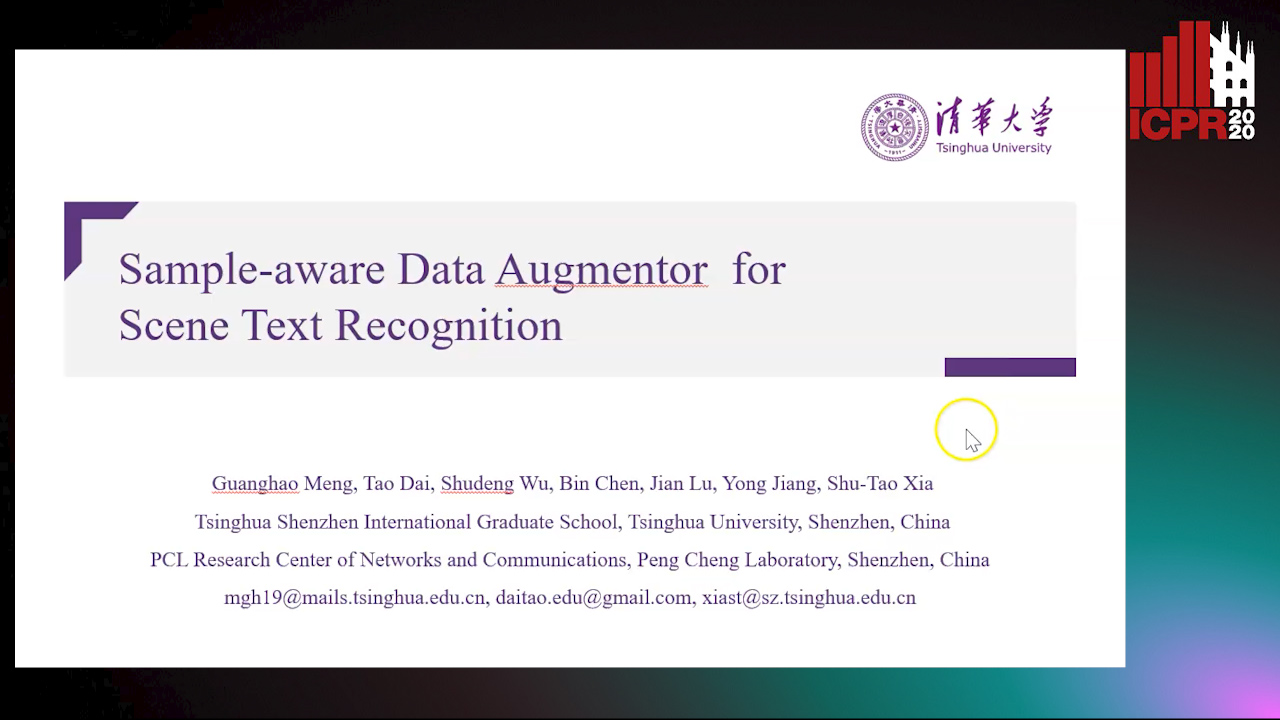
Auto-TLDR; Sample-Aware Data Augmentation for Scene Text Recognition
Abstract Slides Poster Similar
Cost-Effective Adversarial Attacks against Scene Text Recognition
Mingkun Yang, Haitian Zheng, Xiang Bai, Jiebo Luo

Auto-TLDR; Adversarial Attacks on Scene Text Recognition
Abstract Slides Poster Similar
Cross-Lingual Text Image Recognition Via Multi-Task Sequence to Sequence Learning
Zhuo Chen, Fei Yin, Xu-Yao Zhang, Qing Yang, Cheng-Lin Liu

Auto-TLDR; Cross-Lingual Text Image Recognition with Multi-task Learning
Abstract Slides Poster Similar
Unsupervised deep learning for text line segmentation
Berat Kurar Barakat, Ahmad Droby, Reem Alaasam, Borak Madi, Irina Rabaev, Raed Shammes, Jihad El-Sana
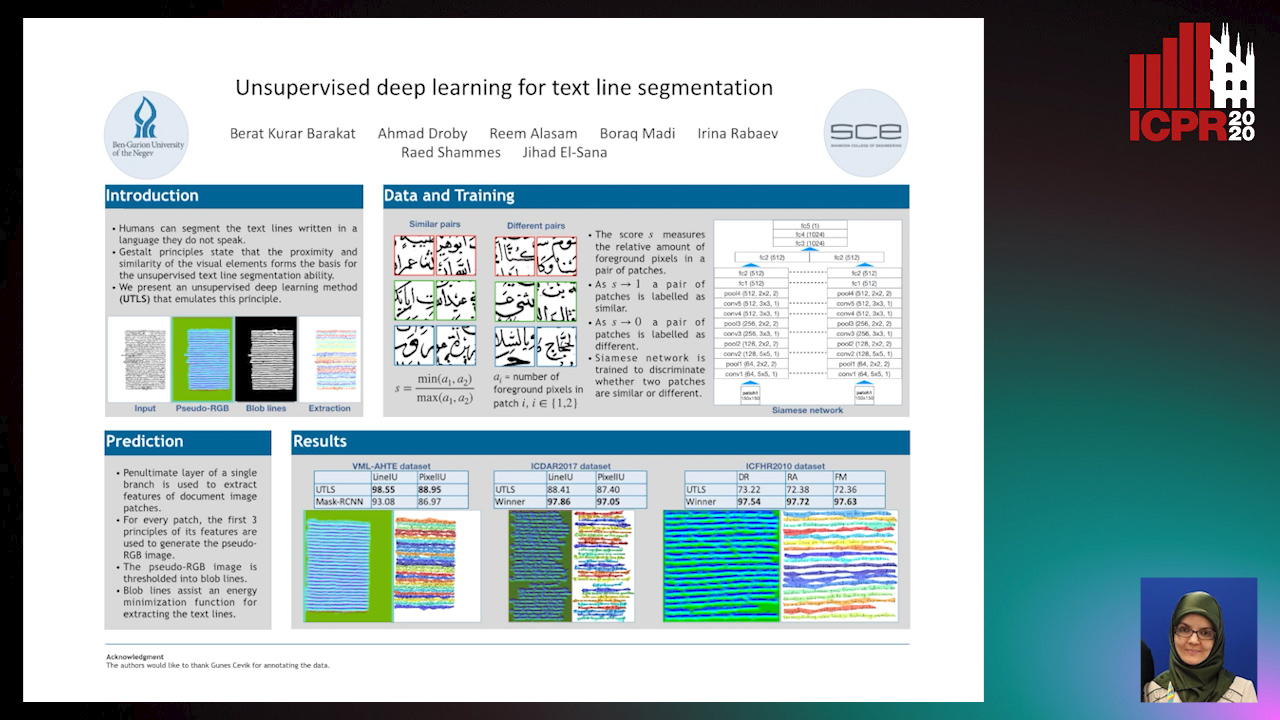
Auto-TLDR; Unsupervised Deep Learning for Handwritten Text Line Segmentation without Annotation
An Evaluation of DNN Architectures for Page Segmentation of Historical Newspapers
Manuel Burghardt, Bernhard Liebl

Auto-TLDR; Evaluation of Backbone Architectures for Optical Character Segmentation of Historical Documents
Abstract Slides Poster Similar
Planar 3D Transfer Learning for End to End Unimodal MRI Unbalanced Data Segmentation
Martin Kolarik, Radim Burget, Carlos M. Travieso-Gonzalez, Jan Kocica

Auto-TLDR; Planar 3D Res-U-Net Network for Unbalanced 3D Image Segmentation using Fluid Attenuation Inversion Recover
UDBNET: Unsupervised Document Binarization Network Via Adversarial Game
Amandeep Kumar, Shuvozit Ghose, Pinaki Nath Chowdhury, Partha Pratim Roy, Umapada Pal

Auto-TLDR; Three-player Min-max Adversarial Game for Unsupervised Document Binarization
Abstract Slides Poster Similar
An Accurate Threshold Insensitive Kernel Detector for Arbitrary Shaped Text
Xijun Qian, Yifan Liu, Yu-Bin Yang

Auto-TLDR; TIKD: threshold insensitive kernel detector for arbitrary shaped text
Weakly Supervised Attention Rectification for Scene Text Recognition
Chengyu Gu, Shilin Wang, Yiwei Zhu, Zheng Huang, Kai Chen

Auto-TLDR; An auxiliary supervision branch for attention-based scene text recognition
Abstract Slides Poster Similar
Fusion of Global-Local Features for Image Quality Inspection of Shipping Label
Sungho Suh, Paul Lukowicz, Yong Oh Lee

Auto-TLDR; Input Image Quality Verification for Automated Shipping Address Recognition and Verification
Abstract Slides Poster Similar
Hybrid Approach for 3D Head Reconstruction: Using Neural Networks and Visual Geometry
Oussema Bouafif, Bogdan Khomutenko, Mohammed Daoudi

Auto-TLDR; Recovering 3D Head Geometry from a Single Image using Deep Learning and Geometric Techniques
Abstract Slides Poster Similar
Automatic Semantic Segmentation of Structural Elements related to the Spinal Cord in the Lumbar Region by Using Convolutional Neural Networks
Jhon Jairo Sáenz Gamboa, Maria De La Iglesia-Vaya, Jon Ander Gómez

Auto-TLDR; Semantic Segmentation of Lumbar Spine Using Convolutional Neural Networks
Abstract Slides Poster Similar